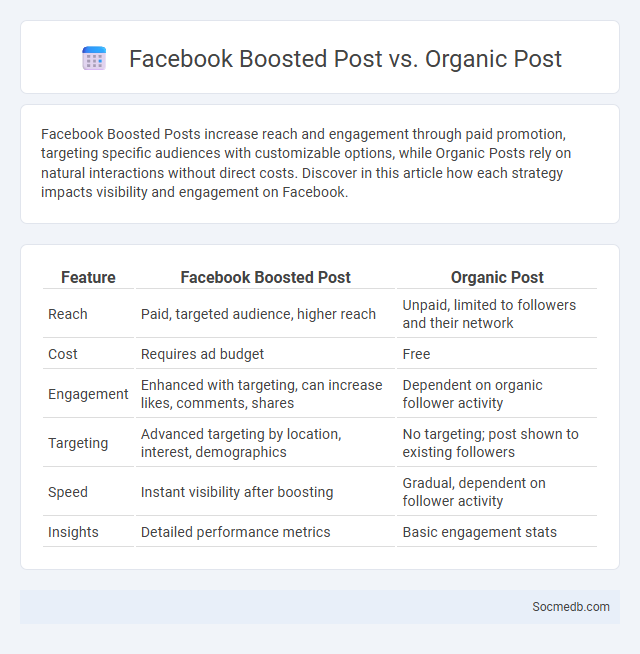
Photo illustration: Facebook Boosted Post vs Organic Post
Facebook Boosted Posts increase reach and engagement through paid promotion, targeting specific audiences with customizable options, while Organic Posts rely on natural interactions without direct costs. Discover in this article how each strategy impacts visibility and engagement on Facebook.
Table of Comparison
| Feature | Facebook Boosted Post | Organic Post |
|---|---|---|
| Reach | Paid, targeted audience, higher reach | Unpaid, limited to followers and their network |
| Cost | Requires ad budget | Free |
| Engagement | Enhanced with targeting, can increase likes, comments, shares | Dependent on organic follower activity |
| Targeting | Advanced targeting by location, interest, demographics | No targeting; post shown to existing followers |
| Speed | Instant visibility after boosting | Gradual, dependent on follower activity |
| Insights | Detailed performance metrics | Basic engagement stats |
Understanding Facebook Boosted Posts
Facebook boosted posts increase reach by promoting existing content to a targeted audience, enhancing engagement and visibility. Businesses leverage detailed audience targeting options, such as demographics, interests, and behavior, to optimize ad effectiveness. Insights from boosted posts provide valuable data on post performance, helping refine future social media marketing strategies.
What Is an Organic Post on Facebook?
An organic post on Facebook refers to content shared on a user's timeline or page without paid promotion, relying solely on natural visibility and user engagement. These posts reach followers and friends through Facebook's algorithm, which prioritizes content based on relevance and interaction rather than monetary investment. Effective organic posts often include engaging visuals, authentic messaging, and calls to action to maximize reach and foster community connections.
The Key Features of Boosted Posts
Boosted posts on social media platforms like Facebook and Instagram increase content visibility by targeting specific demographics based on location, age, interests, and behaviors. These posts enhance engagement through precise audience segmentation, optimized budget control, and flexible scheduling options, allowing businesses to reach potential customers effectively. Key features include measurable analytics for tracking reach, clicks, and conversions, ensuring campaigns deliver tangible marketing results.
Organic Reach: Pros and Cons
Organic reach on social media allows brands to connect with their audience without paid advertising, fostering authentic engagement and building long-term community trust. Limited by platform algorithms, organic reach often suffers from reduced visibility, making it challenging to achieve significant exposure or rapid growth. Balancing organic efforts with strategic content creation can maximize engagement while minimizing marketing costs.
Differences Between Boosted and Organic Posts
Boosted posts on social media involve paid promotion to reach a wider, targeted audience beyond your followers, often resulting in increased visibility and engagement metrics more rapidly. Organic posts rely solely on the platform's algorithm to distribute content naturally to followers and their networks without direct cost, typically fostering more genuine interaction and long-term community growth. The key difference lies in cost and reach: boosted posts guarantee expanded exposure through paid ads, whereas organic posts depend on content quality and timing to maximize natural engagement.
Cost Analysis: Boosted Posts vs Organic Posts
Boosted posts on social media often require a clear cost analysis to determine return on investment compared to organic posts, which have no direct financial outlay but rely on engagement and shareability. You should evaluate metrics such as reach, engagement rate, and conversion cost to decide whether paid promotion genuinely enhances your content's visibility and leads to measurable business outcomes. Understanding the budget allocation between boosted and organic strategies ensures more efficient use of marketing resources and better overall campaign performance.
Audience Targeting Options
Social media platforms offer diverse audience targeting options such as demographic filters, interest-based categories, and behavioral data to enhance ad precision. Tools like Facebook Ads Manager enable advertisers to create custom audiences by combining location, age, gender, and user activity for highly tailored campaigns. Leveraging lookalike audiences and retargeting strategies optimizes reach and engagement, maximizing conversion rates across channels.
Engagement Rates: Boosted vs Organic
Engagement rates on social media significantly differ between boosted and organic content, with boosted posts typically achieving higher visibility and interaction due to targeted ad spend. Organic engagement relies on genuine audience interest and content relevance, often leading to more authentic interactions but lower reach compared to boosted posts. To maximize your social media impact, balancing boosted campaigns with strong organic content strategies ensures sustained growth and engagement.
Which Is Better for Business Goals?
Choosing the right social media platform for business goals depends on target audience, industry, and content type. LinkedIn is ideal for B2B marketing and professional networking, while Instagram excels in visual branding and consumer engagement. Facebook offers extensive advertising tools and diverse demographics, making it versatile for both B2C and B2B strategies.
Best Practices for Mixing Boosted and Organic Content
Balancing boosted and organic content on social media enhances audience engagement and maximizes reach. Your strategy should prioritize organic posts for authentic interaction while using boosted content to target specific demographics and amplify key messages. Consistent analysis of performance metrics ensures optimal allocation of budget and content types for sustained growth.
 socmedb.com
socmedb.com